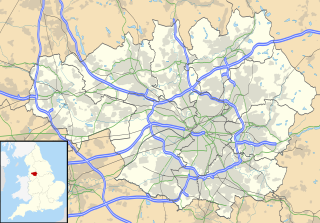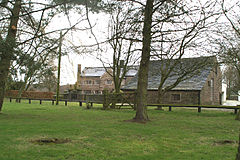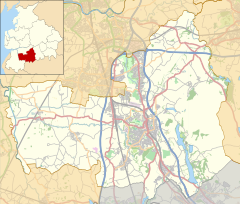
Bolton and Undercliffe is an electoral ward in the City of Bradford Metropolitan District Council, England. The population of the ward at the 2011 Census was 16,365. Bolton and Undercliffe covers the area east of Bradford Beck, between Shipley & Wrose to the north and central Bradford to the south. It is a largely urban area.

Burland is a village and civil parish in the unitary authority of Cheshire East and the ceremonial county of Cheshire, England, about 2½ miles west of Nantwich. The civil parish also includes the small settlements of Burland Lower Green, Burland Upper Green, Hollin Green and Stoneley Green, as well as parts of Gradeley Green and Swanley. The eastern part of the village of Ravensmoor also falls within the civil parish.

Bromley Cross is a suburb of the unparished area of South Turton in the Metropolitan Borough of Bolton, Greater Manchester, England. It gives its name to the larger Bromley Cross electoral ward, which includes Eagley, Egerton, and Cox Green. Historically a part of Lancashire, Bromley Cross lies on the southern edge of the West Pennine Moors.

Lostock Hall Gatehouse is an Elizabethan building located in Lostock, a western suburb of Bolton in Greater Manchester, England.
Charnock Richard is a civil parish in the Borough of Chorley, Lancashire, England. The parish contains 12 buildings that are recorded in the National Heritage List for England as designated listed buildings. Of these, two are listed at Grade II*, the middle grade, and the others are at Grade II, the lowest grade. Apart from the village of Charnock Richard, the parish is rural. Most of the listed buildings are, or originated as, farmhouses and farm buildings. The other listed buildings consist of a church, a bridge, a school and schoolmaster's house, and almshouses with associated buildings.
Hoghton is a civil parish in the Borough of Chorley, Lancashire, England. It contains 15 buildings that are recorded in the National Heritage List for England as designated listed buildings. Of these, two are listed at Grade I, the highest of the three grades, and the others are at Grade II, the lowest grade. The major building in the parish is Hoghton Tower; this and associated structures are listed. Otherwise the parish in mainly rural, and a number of farmhouses and farm buildings are listed. The other listed buildings consist of two churches, a former school, and a railway viaduct.
Bolton-le-Sands is a civil parish in Lancaster, Lancashire, England. It contains 36 listed buildings that are recorded in the National Heritage List for England. Of these, two are listed at Grade II*, the middle grade, and the others are at Grade II. Most of the listed buildings are houses, farmhouses and cottages dating from the 17th, 18th and early 19th centuries. The Lancaster Canal passes through the parish, and five bridges crossing it are listed. The other listed buildings include two churches, two schools, two public houses, a barn, a milestone, a cross base, and a pinfold.
Caton-with-Littledale is a civil parish in Lancaster, Lancashire, England. It contains 53 listed buildings that are recorded in the National Heritage List for England. Of these, two are listed at Grade II*, the middle grade, and the others are at Grade II. The parish contains the villages and smaller settlements of Caton, Brookhouse, Littledale, Caton Green, and Crossgill. It is otherwise rural, with a number of isolated farms. Many of the listed buildings are houses and associated structures in the settlements and in the surrounding countryside. The other listed buildings include a church, disused chapels, a cross base, bridges, two former mills, and two milestones.
Halton-with-Aughton is a civil parish in Lancaster, Lancashire, England. It contains 46 listed buildings that are recorded in the National Heritage List for England. Of these, one is listed at Grade I, the highest of the three grades, three are at Grade II*, the middle grade, and the others are at Grade II, the lowest grade.
Tatham is a civil parish in Lancaster, Lancashire, England. It contains 47 buildings that are recorded in the National Heritage List for England as designated listed buildings. Of these, two are at Grade II*, the middle grade, and the others are at Grade II, the lowest grade. Apart from the small settlement of Lowgill, the parish is rural, containing widespread farms. Most of the listed buildings are farmhouses, farm buildings and houses. The other listed buildings include two churches, two boundary stones, a derelict colliery engine house, a public house, and a telephone kiosk.
Bolton-by-Bowland is a civil parish in Ribble Valley, Lancashire, England. It contains 44 listed buildings that are recorded in the National Heritage List for England. Of these, one is listed at Grade I, the highest of the three grades, three are at Grade II*, the middle grade, and the others are at Grade II, the lowest grade. The parish contains the village of Bolton-by-Bowland and the settlement of Holden, and surrounding countryside. Most of the listed buildings are houses and associated structure, farmhouses, and farm buildings. Also listed are crosses, cross bases, churches and associated structures, bridges, a wellhouse, a school, a public house, and stocks.
Easington is a civil parish in Ribble Valley, Lancashire, England. It contains nine listed buildings that are recorded in the National Heritage List for England. Of these, one is at Grade II*, the middle grade, and the others are at Grade II, the lowest grade. The parish is entirely rural. The oldest listed building is a medieval cross base, and the most important is Hammerton Hall, a country house. The other listed buildings are all farmhouses or farm buildings.
Salesbury is a civil parish in Ribble Valley, Lancashire, England. It contains four listed buildings that are recorded in the National Heritage List for England. All of the listed buildings are designated at Grade II, the lowest of the three grades, which is applied to "buildings of national importance and special interest". The parish contains the village of Salesbury and the residential area of Copster Green, and is otherwise rural. The listed buildings consist of a farmhouse with an attached stable, and two houses, one with a sundial base in the grounds.
Lathom South is a civil parish in the West Lancashire district of Lancashire, England. It contains four listed buildings that are recorded in the National Heritage List for England. All the listed buildings are designated at Grade II, the lowest of the three grades, which is applied to "buildings of national importance and special interest". The parish is rural, and all the listed buildings are farmhouses or farm buildings.
Bolton is a civil parish in the Eden District, Cumbria, England. It contains 14 buildings that are recorded in the National Heritage List for England. Of these, one is listed at Grade I, the highest of the three grades, two are at Grade II*, the middle grade, and the others are at Grade II, the lowest grade. The parish contains the village of Bolton, and is otherwise rural. The listed buildings comprise the former residence of the Bishops of Carlisle, now in ruins, a church and structures in the churchyard, houses in the village, a farmhouse and barn, a bridge, and a country house with associated structures.
Blackrod is a civil parish in the Metropolitan Borough of Bolton, Greater Manchester, England. It contains 13 listed buildings that are recorded in the National Heritage List for England. All the listed buildings are designated at Grade II, the lowest of the three grades, which is applied to "buildings of national importance and special interest". The parish is partly residential but mainly rural. The Leeds and Liverpool Canal passes through the parish and there are five listed buildings associated with it, an aqueduct and four bridges. The other listed buildings are a former country house and associated structures, farmhouses, a hotel, a church, and a war memorial.
Horwich is a civil parish in the Metropolitan Borough of Bolton, Greater Manchester, England. It contains 19 listed buildings that are recorded in the National Heritage List for England. All the listed buildings are designated at Grade II, the lowest of the three grades, which is applied to "buildings of national importance and special interest". The parish contains the town of Horwich and the surrounding countryside. It has an industrial heritage, including a bleach works, and a locomotive factory. The listed buildings include buildings surviving from the bleach works, a war memorial associated with the locomotive factory, houses and farmhouses, churches, a public house, a parish hall, a school, and a set of stocks.
Bolton is a town in the Metropolitan Borough of Bolton, Greater Manchester, England, and its central area is unparished. The central area of the town contains over 230 listed buildings that are recorded in the National Heritage List for England. Of these, three are listed at Grade I, the highest of the three grades, 13 are at Grade II*, the middle grade, and the others are at Grade II, the lowest grade.
South Turton is an unparished area in the Metropolitan Borough of Bolton, Greater Manchester, England, and includes the settlements of Bradshaw, Bromley Cross, Harwood, Dunscar, Eagley, and Egerton, and the surrounding countryside. The area contains 28 listed buildings that are recorded in the National Heritage List for England. Of these, two are listed at Grade II*, the middle of the three grades, and the others are at Grade II, the lowest grade. The listed buildings include houses and associated structures, farmhouses, farm buildings, former cotton mills, a church and an isolated church tower, a former school, a railway station, and a war memorial.
Ashton-in-Makerfield is a town in the Metropolitan Borough of Wigan, Greater Manchester, England. It contains ten listed buildings that are recorded in the National Heritage List for England. All the listed buildings are designated at Grade II, the lowest of the three grades, which is applied to "buildings of national importance and special interest". Industry, including coal mining, came to the town in the 19th century, but it is now mainly residential. The older listed buildings consist of farmhouses, a farm building, a chapel and a milestone, and the later ones are churches and associated structures, and a library.








